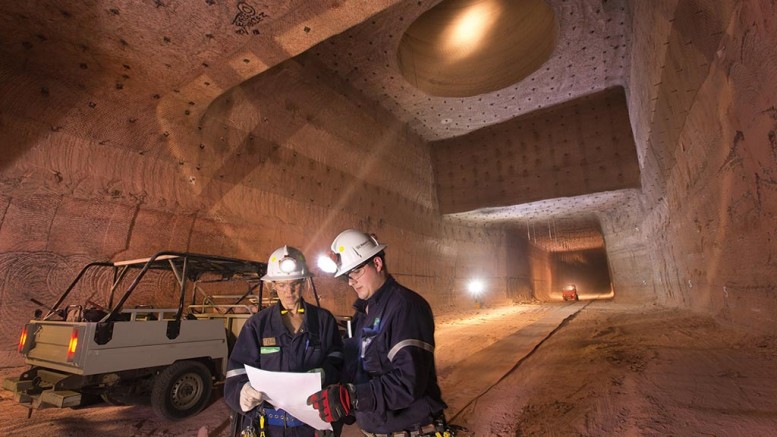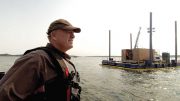Manitoba and Saskatchewan consistently rank top among the world’s premiere jurisdictions for mining and mineral exploration, and so, with prices for gold, copper, zinc and lead all strengthening, it’s no wonder the two Prairie provinces are the setting for a fresh round of programs by junior explorers. The following is a quick look at seven such juniors.
ALTIUS MINERALS
With its headquarters in St. John’s, N.L., Altius Minerals (TSX: ALS; US-OTC: ATUSF) has a diverse portfolio of royalties, streams and shares in junior explorers.
Altius holds royalty interests in 13 producing assets in Canada that include a 4% net smelter return royalty on Hudbay’s 777 copper-zinc mine in Manitoba, six potash mines and five coal mines in Western Canada, a royalty on Vale’s Voisey’s Bay nickel-copper-cobalt mine in Labrador and a 3.7% stream interest on Yamana Gold’s Chapada mine in Brazil. Altius also gets regular dividend income from its equity ownership in Labrador Iron Ore Royalty Corporation.
Altius says collectively these royalties should generate $55 million in revenue per year at current metal prices.
Altius still has a hand in the exploration game, however, and recently reported finding macro-diamonds at its 608 sq. km Lynx diamond project near the community of Oxford House in northeast Manitoba, halfway between Thompson and the provincial border with Ontario.
The property was optioned from a consortium of prospectors and geologists who worked with the Geological Survey of Manitoba in 2016 in the Knee Lake area. Altius followed up with channel and grab sampling in June and July, with positive diamond counts announced in September.
ALTO VENTURES

Location map of Alto Ventures’ Oxford Lake gold property near Oxford House, Manitoba. Credit: Alto Ventures.
Vancouver-based Alto Ventures (TSXV: ATV; US-OTC: ALVLF) is another junior active in the Oxford Lake area of northeastern Manitoba, with its Oxford Lake gold property at the western end of the lake, which is characterized by iron formation-hosted gold occurrences.
Noranda drilled the property between 1988 and 1992, delineating a historical 154,000 oz. gold in the property’s Rusty zone at a grade of 6 grams gold per tonne over 2.5 metres wide to 700 metres deep.
Alto drilled three shallow holes in 2012 that confirmed gold on the property.
Alto spent $400,000 exploring the property in mid-2017, and is now proposing a $1.3-million drilling campaign in the first quarter of 2018, followed by $3 million and $6 million drill programs in 2019 and 2020.
In October, Alto announced it would try to raise $525,000 in a private placement, with half of that raised at press time.
Alto also has gold assets in the Abitibi region of Quebec. The company is led by CEO Rick Mazur and president Mike Koziol.
CALLINEX MINES

A drill site at Callinex Mines’ Pine Bay zinc project in Manitoba. Credit: Callinex Mines.
Zinc junior Callinex Mines (TSXV: CNX; US-OTC: CLLXF) has advanced projects in western Newfoundland and northern New Brunswick with substantial defined resources, and more grassroots projects in central Manitoba.
Callinex’s efforts in Manitoba centre on two projects: Pine Bay, which comprises four volcanogenic massive sulphide (VMS) deposits; and Flin Flon, which has geological strata like those seen at Hudbay Minerals’ 777 mine, located 3 km away.
Callinex is led by president and CEO Max Porterfield, and chairman Mike Muzylowski — a member of the Canadian Mining Hall of Fame.
Shareholders are divided between retail investors (40%), insiders and close associates (29%), and institutions (31%), including Resource Capital Funds, Sprott Group, Plethora Precious Metals Fund and Fieldhouse Capital Management.
FORAN MINING

Drillers at Foran Mining’s McIlvenna Bay copper-zinc deposit in central eastern Saskatchewan. Credit: Foran Mining.
Foran Mining (TSXV: FOM; US-OTC: FMCXF) is another junior explorer basking in the resurgence of copper and zinc prices. It is focused on advancing its substantial, fully owned McIlvenna Bay copper-zinc deposit and nearby Hanson Lake VMS camp in central eastern Saskatchewan.
As of 2013, indicated resources at McIlvenna Bay stood at 13.9 million tonnes grading 1.28% copper, 2.67% zinc, 0.49 gram gold per tonne and 17 grams silver per tonne, while inferred resources were 11.3 million tonnes at 1.32% copper, 2.97% zinc, 0.43 gram gold and 17 grams silver.
A preliminary economic assessment (PEA) of McIlvenna Bay by consultants JDS Energy and Mining in January 2015 envisioned a $249-million, 5,000-tonne-per-day conventional underground mining operation using longhole stoping methods and cemented paste backfill.
Total payable production over a 14-year mine life was expected to be 513.7 million lb. copper, 804.7 million lb. zinc, 15.8 million lb. lead, 218,000 oz. gold and 5.44 million oz. silver.
Foran is working to show the project deserves advancement to a feasibility study, and contracted Micon International in April to carry out a technical review of the 2015 PEA.
MURCHISON MINERALS

Location map of Murchison Minerals’ Brabant-McKenzie zinc-copper project, 175 km northeast of La Ronge in northern Saskatchewan. Credit: Murchison Minerals.
Toronto-based junior Murchison Minerals (TSXV: MAM) has had a strong year exploring its wholly owned Brabant-McKenzie high-grade zinc-copper project in northern Saskatchewan, 175 km northeast of La Ronge and 3 km east of the community of Brabant Lake. The project is accessible by road and service by grid power.
Thanks to a successful 10-hole, 5,600-metre drilling campaign carried out in early 2017, the company has recently updated the resource for the Brabant-McKenzie deposit to 1.5 million indicated tonnes grading 7.46% zinc, 0.70% copper, 0.39% lead and 31.16 grams silver per tonne (or 10.09% zinc equivalent), plus another 4.5 million inferred tonnes at 5.99% zinc, 0.62$ copper, 0.39% lead and 19.39 grams silver (or 7.99% zinc equivalent).
Murchison says the deposit is open to depth and laterally, and there are “significant infill opportunities” from 610 metres down-dip to 950 metres.
In 2018, Murchison aims to expand the resource to 9 to 11 million tonnes at similar grades, and upgrade inferred resources to the indicated category.
To that end, Murchison is proposing a $3-million private placement of ordinary and flow-through shares. It already has $1 million in cash.
Quite a few veteran mining executives are guiding Murchison. The company is led by president and CEO Kent Pearson and chief financial officer Erik Martin, while the board is comprised of Pearson, chairman Jean-Charles Potvin, David Pyper, Denis Arsenault, Donald K. Johnson and John G.P. Dixon.
The largest shareholders are Donald K. Johnson (37.1%), Rob McEwen (14.2%) and management (9.2%).
QMC QUANTUM MINERALS

Historical marker at QMC Quantum Minerals’ Cat Lake lithium property in Manitoba. Credit: QMC Quantum Minerals.

Close-up of plaque at historical marker at QMC Quantum Minerals’ Cat Lake lithium property in Manitoba. Credit: QMC Quantum Minerals.
Vancouver-based QMC Quantum Minerals (TSXV: QML; US-OTC: QMCQF) is on the hunt for lithium and precious metals in Manitoba.
QMC describes its Cat Lake lithium project north of Cat Lake, Man., as containing a rare metal (lithium-tantalum-cesium) deposit within the Irgon pegmatite dike, with substantial developmental work carried out by former owner Lithium Corp. of Canada, which delineated a resource of at least 1.2 million tonnes of spodumene-bearing pegmatite grading 1.5% Li2O.
QMC struck a deal to acquire the property a year ago and is engaged in stripping, geological mapping and channel sampling over the 400-metre surface exposure of the Irgon dike, with follow-up drilling to come.
In early November, QMC raised gross proceeds of $774,000 by issuing 6.45 million units priced at 12¢ per unit, with each unit comprised of a share and a warrant allowing the holder to buy another shares for 17¢ within 18 months.
SATORI RESOURCES

Old mill infrastructure on Satori Resources’ Tartan Lake gold project in Manitoba’s Flin Flon mineral belt. Credit: Satori Resources.
Satori Resources (TSXV: BUD; US-OTC: STRRF) is another junior active in Manitoba’s Flin Flon mineral belt, where it is exploring its wholly owned Tartan Lake gold project.
The 27 sq. km property hosts a mothballed, high-grade underground mine that produced 47,000 oz. gold between 1987 and 1989.
Satori says the deposit is open at depth and along strike, and there are numerous gold showings throughout property, which has seen limited drilling and few modern exploration techniques.
The company notes there is substantial infrastructure in place that needs refurbishment, including a decline ramp with 2,100 metres of underground development down to 310 metres, six levels of development, vent raise, tailings pond, operational power and a 500-tonne-per-day mill.
A National Instrument 43-101-compliant resource was recently calculated at 1.2 million indicated tonnes grading 6.32 grams gold per tonne (240,000 oz. gold) plus 240,000 inferred tonnes at 4.89 grams gold (37,000 oz. gold), using a 3 gram gold cut-off.





Be the first to comment on "Canadian Prairies Snapshot: Seven juniors hitting fifth gear"